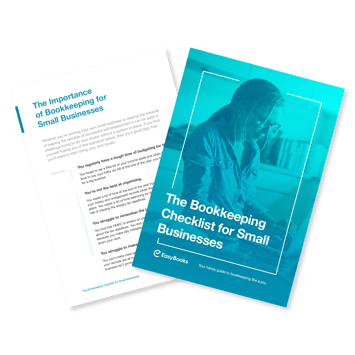10 Easy Examples of Bookkeeping for Small Businesses
To do the books for your small business, you need to be aware of all of the different account types. These include accounts payable, inventory, cash and many more that we’ve outlined in this blog.
To help you get started, we’ve outlined 10 easy types of accounts and what they mean in an easy-to-understand way.
- Accounts Payable
- Accounts Receivable
- Cash
- Inventory
- Loans Payable
- Owners’ Equity
- Purchases
- Payroll Expenses
- Retained Earnings
- Sales
1. Accounts Payable
We get it, it always hurts a little inside when you have to spend money in your business. However, accounts payable gives you a much clearer view of everything you spend. Think of this account as one that represents the money that your business owes in the form of bills and invoices from vendors.
If you’re good at bookkeeping, then you’ll ensure timely payments but most importantly, you won’t end up paying anybody twice.
2. Accounts Receivable
Accounts receivable (AR) is pretty much the exact opposite of accounts payable. If you sell a product or service and you don’t collect payment immediately, then your small business has receivables which you track in this account.
AR is money due to your business from your customers. It’s important you keep this up to date so that you can send timely and accurate bills and invoices.
3. Cash
Perhaps the simplest one on this entire list. A cash account is one where all of your business transactions pass through to track all of your financial activity. Plus, a cash account is arguably the simplest way to record cash payments, withdrawals and deposits.
4. Inventory
All of the products your business has in stock (whether they’re sitting at the back or still sat on the shelf) need to be carefully tracked and accounted for. This part is important because the numbers you have in your books should match by doing physical counts of the inventory on hand.
You can track inventory in two ways. Either periodically where you make a physical count of the inventory daily, monthly, yearly or any other period that matches your business needs. Or whenever you make a sale - do whichever is easier for you and your business.
5. Loans Payable
Let’s say you’ve borrowed money. It can be anything from buying equipment like computers, vehicle to help you get from A to B when on the job or even furniture and other items for your business. All of these expenses fall under the loans payable account which tracks what you owe and what’s due for you to pay.
6. Owner’s Equity
The owner’s equity account follows the amount each owner puts into the business. Small businesses are usually owned by one person or a group of partners, so there are no real stock shares to divide the ownership.
Instead, all of the money put into the business is tracked in capital accounts and money taken out appears in drawing accounts. What’s important here is that your books should carefully record all of the owners’ equity accounts.
7. Purchases
The purchases account should also be something you look at when doing your books. This is where you track any raw materials or finished goods that you buy for your business.
It’s a big part of calculating the costs of goods sold which you subtract from the sales account to find your business’ gross profit.
8. Payroll Expenses
If your small business is one that has employees, then this could be the most significant cost and an account you can’t ignore when doing your books.
Nobody wants to work for free. So keeping this account accurate and always up-to-date is vital for when you need to meet tax reporting requirements. Ignore this and don’t be surprised if you land in hot water with the taxman.
9. Retained Earnings
When you do your books, the retained earnings account is one which tracks your company’s profits that you reinvest into the business and don’t keep for yourself or pay out to other owners.
Retained earnings are cumulative, which means that they’ll appear as a running total of money you’ve maintained since your business started. In all honesty, managing this account doesn’t take much time, so make sure you track it to see how much your business has grown.
10. Sales
Another necessary yet massively important account to follow when doing your books. It’s no surprise why business owners love this one, as the sales account is where you record all incoming revenue from what you sell.
Make sure you record your sales accurately and on time so that you know where your business stands. Remember, it’s to help both your business grow and stop HMRC from kicking up a fuss.
When you start to do bookkeeping for your small business, you should be aware of the different types of accounts that you need to maintain. So, here’s a really easy way to make the process straightforward...
Kickstart Your Bookkeeping Journey With Your Very Own Checklist
Bookkeeping doesn’t need to be a tedious task when you know which accounts to track and you have the right tools. To help make the process even easier and make you a pro in no time, we’ve created a handy checklist you can refer to when doing your books.
It’s packed with useful tips on how to get started, what to look for when choosing the right software and much more. Grab your free copy using the link below.







